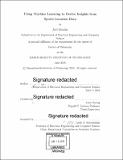Using machine learning to derive insights from sports location data
Author(s)
Brooks, Joel David
DownloadFull printable version (9.129Mb)
Other Contributors
Massachusetts Institute of Technology. Department of Electrical Engineering and Computer Science.
Advisor
John Guttag.
Terms of use
Metadata
Show full item recordAbstract
Historically, much of sports analytics has aimed to find relationships between discrete events and outcomes. The availability of high-resolution event location and tracking data has led to many new opportunities in sports research. However, it is often challenging to apply machine learning to understand a particular aspect of a sport. These tasks typically require learning on high-dimensional data, scarce labels, and multiple interacting agents. In this thesis, we present applications of machine learning to derive insights from location data in soccer and basketball. In each case, we chose a data representation that allows the models to discover the importance of particular features and patterns. We demonstrate how new quantitive metrics can be derived from predictive models. We built a model that uses the location of passes in soccer to predict shots with an AUROC of 0.79. From this model we defined a novel metric that can evaluate the value of any pass. We also trained a model for predicting shot quality using non-shooting player trajectories in basketball. This allows us to calculate offensive contributions by player movement alone. We also developed an encoder-decoder architecture for learning a low-dimensional encoding of player and ball trajectories. When trained in an unsupervised setting, the model learned a representation that lends itself well to possession querying and clustering. We show that these clusters characterize different team styles on offense. Additionally, we trained this same architecture in a semi-supervised setting for set play classification. Compared to only training on labeled data, this framework improved six-way classification accuracy from 69% to 78%. While we chose specific applications of machine learning to sports data for this thesis, the methods described could generalize to other sports-related tasks or other real-world domains with tracking or multi-agent data.
Description
Thesis: Ph. D., Massachusetts Institute of Technology, Department of Electrical Engineering and Computer Science, 2018. Cataloged from PDF version of thesis. Includes bibliographical references (pages 95-100).
Date issued
2018Department
Massachusetts Institute of Technology. Department of Electrical Engineering and Computer SciencePublisher
Massachusetts Institute of Technology
Keywords
Electrical Engineering and Computer Science.